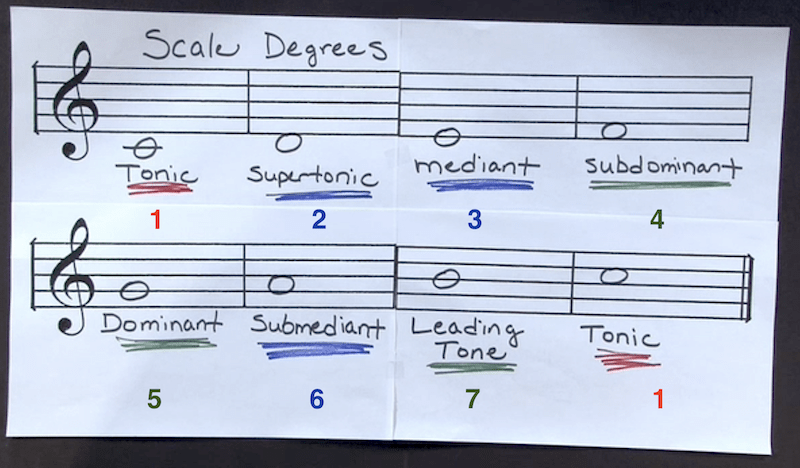- TITLE THIS BLOG POST: Melody Research, Analysis, and Recording Project
- PLACE A CREATIVE COMMONS IMAGE RELATED TO THE PROJECT FROM wordpress.org/openverse AT THE TOP OF THE POST
- FOLLOW THE DIRECTIONS IN THE:
- REVIEW THESE OLDER POST EXAMPLES – THEY ARE A LITTLE DIFFERENT FROM YOURS:
- DELETE ALL OF MR. LE DUC’s INSTRUCTIONS AFTER COMPLETING THEM
Summary
- In a small paragraph, write WHAT THIS PROJECT IS ABOUT. Your audience is someone who is not in the class. So, be specific.
- DELETE ALL OF MR. LE DUC’s INSTRUCTIONS AFTER COMPLETING THEM
My First HookTheory Melody

What I like about this melody is that it was easy to make and I learned how to use a new online tool. I also enjoyed the ending of this melody.
Notes from Howard Goodall’s Melody Video
| Cue | Notes |
| Melody’s carry stories. They express love and loss. Infants can recognize and remember melodies. Every music system in the world shares the same 5 notes. These frequencies were latched on by cultures all around the world at around the same time. These five notes are human genetic inheritance. These are called the pentatonic notes. All cultures developed more notes as time went on, but still used those 5 notes also. All known music systems have chosen notes that sound considerably different. Every 12th rung on a western musical ladder is an A note. Music is not created by somebody, it is already in the imagination waiting for someone to discover it. |
Summary: I learned that music is a lot more than just notes in a certain arrangement. It is a poetic expression that contains the roots of humanity.
Melody Composition Terms and Definitions

- The terms and definitions below are from the Basic Concepts of Music Theory podcast by Jamie Henke at the University of Wisconsin-Madison
- Her Basic Concepts of Music Theory video on YouTube
- Theme: A long, flowing melodic idea.
- Motive: A short, rhythmic idea (Beethoven’s 5th).
- Period: 8-12 measures or a musical sentence.
- Phrase: Usually 4 measures.
- Antecedent (Question) Phrase: First 4 measures of a period.
- Consequent (Answer) Phrase: Second 4 measures of a period.
- Scale Degrees (C Major Scale)
- Tonic: C (1 , 8) – Stability and resolve.
- Supertonic, Mediant, Submediant: D, E, A (2 , 3 , 6) – Moderate tension, useful for transitions and carrying on an idea.
- Subdominant, Dominant, Leading Tone: F, G, B (4 , 5 , 7) – Causes the most tension, leads to the tonic.
- Steps: Any movement using half or whole steps.
- Leaps: Any movement using intervals larger than a whole step.
- Conjunct motion: Melody is built primarily out of steps.
- Disjunct motion: Melody is built primarily out of leaps.
- Repetition: Repeated material (i.e. motive) used to create a link between two phrases of the period.
- Contrast: Two phrases that contain contrasting material to create tension and interest.
- Variation: Halfway between contrast and repetition. The two phrases include some recognizable material and some varied material (i.e. taking ideas up an octave).
One of My Favorite Melodies
I like this melody so much because it gives off a slow and almost melancholic theme. The key it takes place in is B-flat major and the tonic note is B-flat. I noticed that the structure is repeats the same melody over and over for a while.
My Second HookTheory Melody

What I liked about this melody is that the notes seemed to blend well with the rhythm and just how it sounds. I built up tension in the 4th and 5th measures by making the notes go faster and shorter and then I released it with the long notes at the end.
What I Learned & Problems I Solved
From this project I learned how to use Hooktheory and I learned how melodies work and how to make them. One problem I solved was how to shorten or lengthen the notes in the melody, I figured this out by asking my classmates.
Resources
- Assessment a Feedback
- General Music Composition Rubric (Google Doc)
- Period Melody Composition Rubric (PDF)
- Hook Theory Tools and Tutorials
- Music Theory
- Mr. Le Duc’s Key of C Major Notes and Chords Chart (PDF)
- How Music Works with Howard Goodall – Melody
- Melody defined at Wikipedia
- iTunesU – Basic Concepts of Music Theory by Jamie Henke at University of Wisconsin-Madison
- Her Basic Concepts of Music Theory video on YouTube
- https://www.youtube.com/embed/rl-V2IsUprQ
- Michael New
- Art of Composing
- Free MIDI files midiworld.com/files/
- MIDI file of Beethoven’s Ode to Joy from his 9th symphony
- Coldplay Talk sample midi file
- MIDI and Music Notation Editors
- onlinesequencer.net – online
- flat.io – online
- noteflight.com – online
- MuseScore downloadable program
- GarageBand
- Melody Research, Analysis, and Recording Project Feedback Form (PDF)